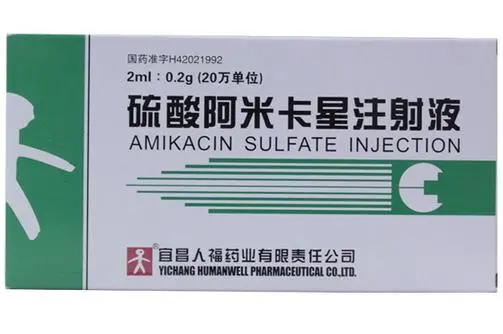Amikacin Sulfate Injection
Effects and efficacy:
This product’s injection, sodium chloride injection, topical preparation and ophthalmic preparation can be used to treat serious infections in adults caused by sensitive strains of the following bacteria. The injection is suitable for serious infections caused by sensitive Gram-negative bacilli such as Pseudomonas aeruginosa and some other Pseudomonas, Escherichia coli, Proteus, Klebsiella, Enterobacter, Serratia, Acinetobacter and Staphylococcus (methicillin-sensitive strains), such as bacteremia or sepsis, bacterial endocarditis, lower respiratory tract infection, bone and joint infection, biliary tract infection, abdominal infection, complicated urinary tract infection, skin and soft tissue infection, etc. Since this product is stable to most aminoglycoside inactivating enzymes, it is particularly suitable for the treatment of serious infections caused by kanamycin, gentamicin or tobramycin-resistant strains of Gram-negative bacilli. Sodium chloride injection is suitable for the short-term treatment of the following serious infections caused by Gram-negative bacteria sensitive to amikacin sulfate, including Pseudomonas, Escherichia coli, Proteus (indole negative and positive), Providencia, Klebsiella, Enterobacter and Acinetobacter, and Staphylococcus: sepsis, including neonatal sepsis; respiratory system infections; bone and joint infections; central nervous system infections, including meningitis; skin and soft tissue infections, including burns and postoperative infections (including vascular surgery); gastrointestinal infections, including peritonitis; complicated and protracted urinary tract infections. This product is not used to treat initial uncomplicated urinary tract infections unless these bacteria are not sensitive to other low-toxic antibiotics. Topical preparations are used for severe traumatic infections caused by sensitive bacteria. Ophthalmic preparations are suitable for conjunctivitis, keratitis, etc. caused by sensitive bacteria.
Usage and dosage:
For specific usage and dosage for different populations and different diseases, please consult a doctor and refer to the drug instructions of different preparations. Adult conventional dose for simple urinary tract infection: intramuscular injection or intravenous drip, 200 mg every 12 hours for patients resistant to commonly used antibacterial drugs. Other systemic infections: intramuscular injection or intravenous drip, 7.5 mg/kg every 12 hours, or 15 mg/kg every 24 hours. The daily dose shall not exceed 1.5 g, and the course of treatment shall not exceed 10 days. Severe traumatic infection: topical application, spray lotion on the affected area, 2-3 times a day. Conjunctivitis, keratitis: ocular administration, eye drops in the eyelids, 1-2 drops at a time, 3-5 times a day. Dosage for renal insufficiency: patients with renal impairment should adjust the dose according to creatinine clearance: patients with creatinine clearance of 50-90 mL/min (excluding 50 mL/min) should be given 60%-90% of the conventional dose (7.5 mg/kg) every 12 hours; patients with creatinine clearance of 10-50 mL/min should be given 20%-30% of the conventional dose every 24-48 hours. Dosage for the elderly: Elderly people should use a smaller therapeutic dose. Routine dose for children Severe infection: Intramuscular injection or intravenous drip, the first dose is 10mg/kg, followed by 7.5mg/kg every 12 hours, or 15mg/kg every 24 hours.
Adverse reactions:
Severe adverse reactions Patients with ototoxicity may experience hearing loss, tinnitus, or a sense of fullness in the ears; a few patients may also experience dizziness, unsteady gait, and other symptoms. Hearing loss generally does not worsen after discontinuation of the drug, but some may continue to develop into deafness after discontinuation of the drug. Nephrotoxicity This product has a certain degree of nephrotoxicity, and patients may experience hematuria, decreased urination frequency or decreased urine volume, increased blood urea nitrogen, and increased blood creatinine. Most of them are reversible and will be relieved after discontinuation of the drug, but there are also reports of individual renal failure. Neuromuscular blockade Amikacin has a similar effect of curare to block acetylcholine and complex calcium ions, which can cause myocardial depression, respiratory failure, etc. It is more likely to occur in patients with existing myasthenia or those who have received muscle relaxants. Other adverse reactions Other adverse reactions include headache, numbness, needle infection, tremor, convulsion, joint pain, drug fever, eosinophilia, abnormal liver function, blurred vision, etc. A small number of patients may experience allergic reactions after taking the drug, including anaphylactic shock, rash, urticaria, drug fever, etc. In addition, amikacin can interfere with normal flora, and long-term use can lead to overgrowth of non-sensitive bacteria.
Drug contraindications:
Contraindicated for allergic reactions to this product Use with caution during pregnancy Use with caution during lactation
Share:
Products
Our offers
Health Classification
Let us work together to protect precious health



























